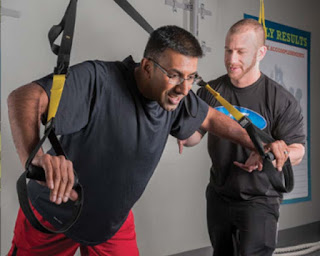Trainer
Tuesdays
Welcome back to the weekly edition on Trainer Tuesdays. Make sure to check in at our blog every Tuesday evening to learn the expertise of our great staff. Aside from being fantastic exercise coaches, they are also extremely knowledgeable in many aspects of health and fitness; so, it's time that you get to know them a little better! Each week, we will post a frequently asked, or sometimes just a fun fitness related question followed by the answers of each of the trainers at Fitness Together Brecksville.
What’s the
difference between BMI and Bodyfat percentage and which one should I pay more
attention to?
Adam Teplitz:
Both BMI and bodyfat percentage are great tools to assess an
individuals overall health. However, they need to be dejected based on who is
getting measured , the purpose of the measurement and the individual's overall
goals.
BMI stands for body mass index. It is a height to weight ratio. The formula consists of taking your
 |
| Fitness Together Personal Trainer Adam Teplitz working with a client |
A great example would be a professional football player who is 6 feet
tall and weighs 250 pounds, with 8.5 percent bodyfat. According to the BMI
calculation , he would have a BMI of 34, and be considered obese. This is
clearly not the case.
When it comes to individuals who are very active, BMI is not the best
route to go. Calculating bodyfat percentage would be the better option.
Bodyfat percentage is how much of your body is composed of fat (
adipose tissue) and how much is composed of muscle , bone , internal organs,
skin, etc. Various methods used to calculate this are Bioelectrical
Impedance analysis , infrared analysis, skin fold calipers, and hydrostatic
weighing.
Personally, I feel like calculating bodyfat percentage is a more
accurate calculation and indication of your overall health.
Kelly Bailey: BMI, or Body Mass Index, is a simple height to weight ratio that assesses
 |
| Fitness Together Personal Trainer Kelly Bailey working with clients |
When people set out to "lose
weight", what they really want to do is lose FAT and maintain or gain lean
tissue. The only way to know if you are losing fat weight and/or gaining
lean muscle tissue is to measure your body fat percentage. In
addition, knowing these numbers can help alleviate frustration if you're
working out, but not seeing the number on the scale (or the BMI number) go
down. It's not an uncommon occurrence for your weight (and BMI) to stay the
same if you've lost fat weight, but gained lean muscle tissue (which, by the
way, is the holy grail of body recomposition!).
Lisa Clark: People have many
misconceptions as to what the difference is in BMI and body fat percentage. In
my opinion BMI should not even be calculated or looked at as a means of telling
a person how much fat or lean muscle mass they have. BMI is strictly based on a
person’s height and weight and takes no consideration for amount of muscle the
person may have. If you took two people weighing in at the exact same weight
and measuring the same height, they would technically have the same BMI number.
However their measurement could be completely off. One could be solid muscle
which we all know is more dense than fat and therefore could look significantly
smaller than the one who doesn't work out and has a higher fat percentage. For
insurance and medical reasons they are both considered to be obese. Is that a
fair measurement?
In contrast to that we also measure people's body fat percentage which can be done using several measurement techniques. Any of these techniques measures the amount of actual fat and lean muscle in a person’s body giving much more accurate results!
©
2015 Fitness Together, Inc. All Rights Reserved. Powered by Fusionbox.
About | Contact | Franchise | Suppliers | History | Leadership | NutritionTogether |Sitemap | PrivacyPolicy | TermsofUse | Facebook | YouTube | Twitter | Linkedin


No comments:
Post a Comment